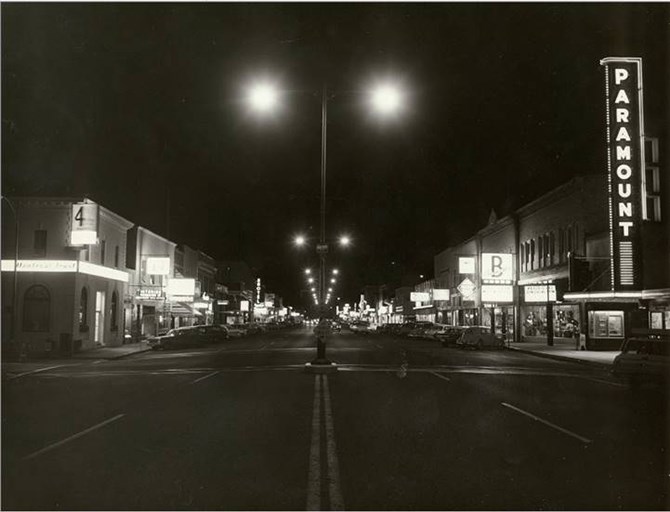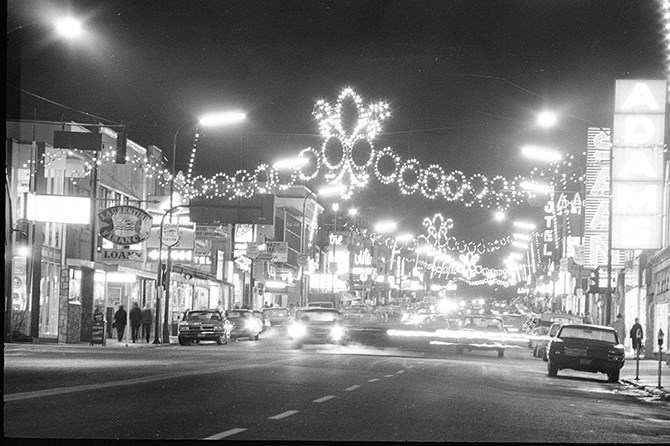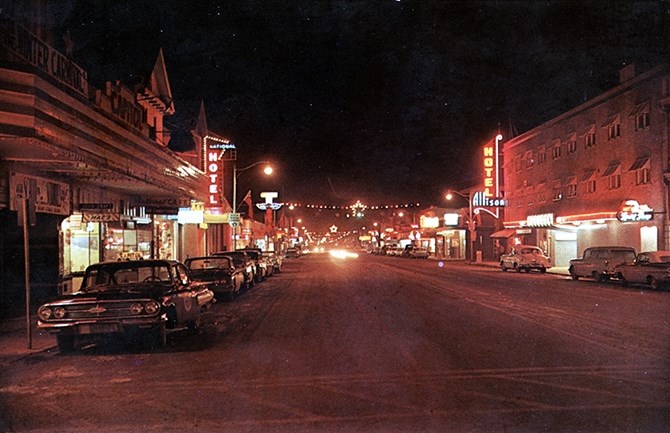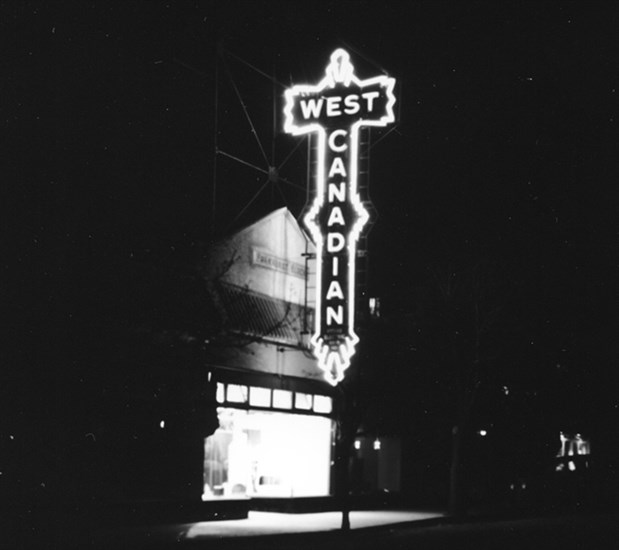
Penticton's downtown was once a hotbed of neon signage.
Image Credit: Penticton Museum Archives PMA 3250
December 05, 2020 - 6:00 PM
It was another era, a time when Kamloops and Okanagan valley cities’ downtown streets lit up in the glow of neon signs.
The brightly lit signage was especially noticeable on winter nights when the day’s early evening darkness gave way to the bright neon lights of downtown.

Kelowna's Paramount movie theater neon sign was a landmark in that city for years.
Image Credit: Kelowna Public Archives
Some of the signs were iconic – in Penticton, the Elite Restaurant is a long-lasting survivor of the age of neon. So too were the Paramount Theatre in Kelowna, the West Canadian in Vernon, and the neon signs of Victoria Street in Kamloops.
Sadly, for the most part, they are all gone now. Neon lost its lustre over the decades for a number of reasons.
In Penticton, historian Randy Manuel says neon signs began their decline after the city council attempted to enact a bylaw eliminating overhead signage in the 1950s.
“Downtown had many unique signs, including the Elite Restaurant, The old Three Gables Hotel, Hudson’s Bay, Knight’s Pharmacy and the Prince Charles Hotel. The bylaw came on the heels of installation of the city’s first stop lights along with the first downtown beautification program that saw many of the downtown facades covered in aluminum,” Manuel says.
The bylaw, which infuriated merchants, was taken to court by a few of those merchants whose neon signs would be affected. The merchants were successful in overturning the bylaw, but not before several businesses changed their signage.
“The city was afraid people would get confused with the neon signage and the new stop lights,” Manuel says.

Penticton's downtown core ablaze with neon and Christmas lighting on Dec. 16, 1969.
Image Credit: Penticton Museum and Archives PMA# 23294
The loss of neon took away the character of Main Street, Manuel says.
“It took years to come back and when it did, it didn’t come back the same way,” he says.
Manuel says Kelowna, Vernon and Kamloops were able to keep their signs a little longer, without having a bylaw to deal with.
Perhaps surprisingly, Penticton was the largest city in the Thompson-Okanagan in the mid-1950s, with a population of 11,894. Kamloops was the smallest city with a population of 9,096.
Oliver-based Outreach Neon Ltd. makes and repairs neon lighting up throughout the Okanagan.
“It’s one of the true artisan parts of the trade. If you talk to just about anyone in our industry, they will tell you they have a great appreciation for neon,” Outreach’s David Konowalchuk says.
He says the main purpose of old neon signage was to provide a light source by lighting up closed space inside sign letters. With the advent of LED lighting nearly two decades ago, the industry found it more cost effective to make signage using the new technology.
“Businesses kind of shifted their branding to accommodate the new light source, looking for something other than the ‘old school’ neon look, if you will,” he says.
Modern uses for neon include clients who still see neon as having a certain glamour to it, and wanting that particular type of look, which Konowalchuk feels can’t be replaced.
He says Outreach does custom work, which includes neon signage inside bars and restaurants where neon can create a certain aesthetic look or feel. They also refurbish older signs still in use.
“We still get the work, it’s just the volume has decreased extremely over the years,” he says.
The technology has become more expensive due to declining volumes, making neon a pricier choice in many cases.
The availability
of parts like glass, rubber boots and transformers is also drying up.

Vernon's downtown on Barnard Avenue in the fading days of neon signage, circa 1960
Image Credit: Greater Vernon Museum and Archives, #21614
Konowalchuk says there has been some resurgence of the industry in parts of North America where interest in a retro look or a particular niche is high, but he says a revival isn’t apparent in the Thompson and Okanagan at this point in time.
“The great percentage of our clients are ones who want to maintain that kind of look that neon provides. The other thing to keep in mind is that LEDs are a much more economical light source. You need more power and maintenance with neon, whereas with LED you can put up the sign and not worry about it for 4 or 5 years. It’s a number of different factors, but it’s all driven by clients,” he says.
It’s worth mentioning Vancouver also has a rich history in neon signage. A 2011 story in the Vancouver Sun by John Mackie detailed a museum exhibit of neon signs, a collection saved from the days when the city had 19,000 neon signs.
Mackie said neon’s days were numbered in Vancouver after a bylaw restricting signage was introduced in 1974. The signs were viewed critically by councillors of the day for being ‘gaudy’ and ‘too loud.'

West Canadian Hydro Electric Corporation Ltd. neon sign in Vernon, circa 1936, believed to be the first neon sign in Vernon.
Image Credit: Greater Vernon Museum and Archives, #9490
Do you have any old photos of neon signs from the area? We'd love to share them. Send to news@infonews.ca.
To contact a reporter for this story, email Steve Arstad or call 250-488-3065 or email the editor. You can also submit photos, videos or news tips to tips@infonews.ca and be entered to win a monthly prize draw.
We welcome your comments and opinions on our stories but play nice. We won't censor or delete comments unless they contain off-topic statements or links, unnecessary vulgarity, false facts, spam or obviously fake profiles. If you have any concerns about what you see in comments, email the editor in the link above.
News from © iNFOnews, 2020